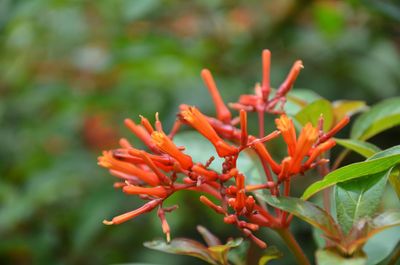Cutting back a firebush needs to be done at the right time in order to preserve the next year’s flowers. Learn when to trim a firebush so you can keep it tidy and still enjoy a lushly blooming plant.
When to Trim a Firebush
Firebush blooms throughout the year in its natural habitat. The brightly colored, tubular flowers come in orange, red and yellow, a veritable sunset of colors. The fruit that forms has a slightly acidic taste and is actually made into a fruit drink in Mexico. Regular pruning can prevent the formation of the fruits, but lightly trimming firebush plants is necessary to keep them in check, as in the case of a hedge. The best time for firebush pruning is late winter to early spring. This is when the plant is not actively growing and such activity will cause less damage. Pruning at this time will prevent removal of flower buds as well. You can prune the plant in summer with no ill effects, but many of the blooms will be lost and fruit will be prevented from forming. Firebush is a semi-woody perennial and will require nice sharp tools to help prevent injury to the plant.
How to Prune a Firebush
Heading back or trimming firebush plants helps the plant form a compact rather than splayed appearance. To do this, you will be hand trimming rather than using a hedging saw. At each branch, cut back to the previous growth node. This will cause the cut area to send out more stems and form a bushier appearance. In order to rejuvenate a neglected firebush, up to one third of the plant may have to be removed. Select the largest, thickest branches for that initial removal. The next season, remove the next largest and repeat the third season. Thereafter, only light trimming annually should be necessary.
Tips on Cutting Back a Firebush
In some regions, such as northern Florida, the plant will die back in winter. As the leaves drop and the stems go dormant, the plant is in a perfect state to be trimmed, but you should wait until just before leaves bud out to prevent any frost injury. It is suggested to prune the plant to a height of no less than 5 feet (1.5 m.) to preserve the flowers. Always use keen edged tools that have been wiped with alcohol or a bleach solution. This prevents injury to the woody tissues and the introduction of disease.
